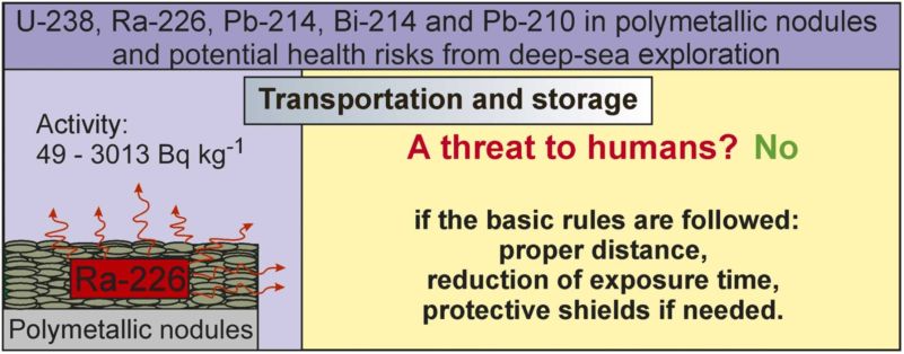What the science says:
- New research provides the first comprehensive estimates of effective radiation doses from handling polymetallic nodules across the full chain of activities — from laboratory analysis to large-scale transport and metallurgical processing, with the following key takeaways:
-
- the occupational exposure in laboratory workplaces is well below the threshold of 1 millisievert per calendar year (mSv/a), even under the most conservative assumptions
- effective doses can be kept well below the exposure limit for personnel on nodule transport vessels and in metallurgical processing facilities with standard radiation protection and mitigation measures common in other industries
-
“There are no health risks when adequate occupational safety measures are applied during activities involving polymetallic nodules”
– Thomas Lüttke, Geoscientist
Metallic ores extracted from the Earth’s crust are often enriched in radioactive isotopes for which they may be classified as Naturally Occurring Radioactive Materials (NORMs). These radioactive isotopes like uranium-238, thorium-232, potassium-40, and radium-226 are found in soil, rocks, water, and even in the air at low concentrations.
Seabed minerals, including polymetallic nodules, have also been found to accumulate the radioisotopes Th-230 and its daughter nuclides, as well as Pa-235 and Ac-227 at concentrations above average levels found in the Earth’s crust. Polymetallic nodules absorb these from seawater, causing an increase of their specific activity especially on their surface. While water is an effective barrier to the alpha radiation originating from these nuclides, processing these ores will technically enhance the specific activity of the material downstream and the release of radon gas can significantly contribute to elevated exposure to radiation if not handled appropriately.
A study published in Nature (Lüttke et al 2025) analysed all dose-relevant radionuclides in polymetallic nodules and the effective radiation dose for various work scenarios was calculated on this basis.
Annual radiation doses are expressed as millisievert per calendar year (mSv/a) and the study concluded that occupational exposure in laboratory workplaces is well below the threshold of 1 mSv/a, even under the most conservative assumptions.
The study also found that effective doses can be kept well below the exposure limit for personnel on nodule transport vessels and in metallurgical processing facilities with standard radiation protection and mitigation measures common in other NORM-affected industries.
Even though the study shows that there are no fundamental health risks associated with the handling of polymetallic nodules, appropriate precautionary measures are necessary and those working with nodules are already taking such measures.
These include strict attention to hygiene, the use of personal protective equipment such as dust masks and safety glasses, keeping nodules damp to suppress dusting, and restricting access to stored nodules to authorized personnel who have been trained to manage exposure time and use proper shielding.
Taken in coordination with the relevant authorities and certification experts, these measures ensure that workers’ exposure to radiation remains well within recommended safe levels.

(Infographic: Assessment of natural radioactivity levels in polymetallic nodules and potential health risks from deep-sea mining. Dołhańczuk-Śródka et al., 2024.)

